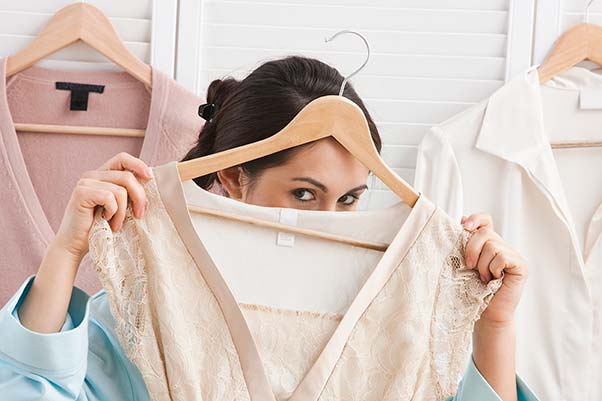It is that time of year again when the kids are back at school, everything is flavored with pumpkin spices, and the weather is cooler. As we head into the new season, it is a good idea to sort your wardrobe for fall and winter so you won’t be scrambling for your favorite sweater on the first chilly day.
Proper wardrobe preparation isn’t just about swapping shorts for sweaters. It’s an opportunity to organize your clothing thoughtfully, maximize your storage space, and make sure your cold-weather essentials are ready when you need them.
Even if you live in a mild climate with subtle seasonal changes, it still makes sense to sort your clothes for the time of year and typical winter clothing trends. That’s why we’ve condensed our favorite fall and winter wardrobe ideas into five easy steps to help you create a practical and stylish cold-weather wardrobe.
Step 1: Sort Your Wardrobe for Seasonal Essentials
To start building your fall and winter wardrobe, conduct a thorough inventory of your clothing. Remove everything from your closet and drawers and group them by category: tops, bottoms, dresses, outerwear, loungewear, sportswear, and accessories.
Decide What to Keep, Donate, or Store
With all your clothing categorized and laid out in front of you, it’s time to make some decisions. Create three sections in your room:
- Keep: This pile will include anything you plan on wearing this season, including transitional pieces that work well for layering.
- Store: Add all your spring and summer clothes in good condition to this pile. That might include shorts, flip-flops, and bathing suits.
- Donate or toss: Get rid of items that no longer fit, show excessive wear, don’t suit your lifestyle, or that you haven’t worn in the past two years. (If you haven’t worn it in two years, chances are you won’t wear it next year.)
Keep in mind that many basic pieces can transition from summer into fall when worn under a jacket or cardigan or layered over tights or a long-sleeve shirt. Pack away any clothes in spring pastel colors, bright floral patterns, or distinctively warm-weather fabrics like linen or seersucker.
Step 2: Essential Pieces for a Practical Fall and Winter Wardrobe
Put your “donate or toss” and “store” clothing piles to the side. It’s time to focus on your “keep” pile. These are the clothing pieces that could work as your winter and fall wardrobe. However, that doesn’t mean you should throw every piece on a hanger, put them in the closet, and call it a day.
If you want to streamline and minimize your wardrobe to only those pieces that will serve you, take the extra time to perform one more filter. Proactively choose each piece in your wardrobe.
Build a Capsule Wardrobe for Fall and Winter
If you want to go the extra step, consider creating a winter and fall capsule wardrobe of versatile and timeless pieces that can be mixed and matched to create multiple outfits. Each piece should be able to work with most or even all of the other pieces in your wardrobe. This minimalist approach focuses on quality over quantity and helps simplify your wardrobe.
Step 3: Organize Your Wardrobe for Accessibility
Now that you have finalized your fall and winter wardrobe essentials, start organizing your pieces in your space. Putting in the time and effort now will make it faster and easier for you to choose great outfits in the future.
- Arrange your closet by clothing category and color
- Put your most frequently worn items at eye level
- Put special occasion items, backup layers, and extra sweaters on your top-level
- Store your shoes and boots on your bottom level in clear boxes
- Keep workout gear and loungewear in drawers
- User drawer dividers to separate smaller items like gloves
- Install hooks and hang frequently worn coats, bags, and scarves
- Consider using slim hangers to maximize your space
Step 4: Store Your Off-Season Items Properly
Let’s not forget about the “store” pile of clothing. Though these items won’t keep you snug in the winter, you’ll want to see them again when the warm weather returns. Properly storing summer clothing will help preserve your valuable pieces and maximize your closet space.
Clean all your to-be-stored items and let them dry completely. Next, fold and store them in waterproof containers or vacuum-sealed bags to protect them against moisture, dust, and pests. Store delicate items (like silk shirts or dresses) flat and roll knit items instead of folding to prevent creases. Label your containers and bags for easy retrieval in the spring.
Now, consider where you plan to store your warm-weather clothing. Good options include:
- Under the bed
- On high closet shelves
- Hall closets
- A garage shelf
- A storage unit
Step 5: Take Care of Your Fall and Winter Wardrobe
Once you have chosen and organized your fall and winter wardrobe, don’t forget about your pieces over the season. If you have invested in quality items, be sure to take great care of your clothes.
- Check and follow the care labels on each clothing piece after wear
- Avoid overwashing sweaters and wool items
- Hang coats on padded hangers
- Spot clean all stains promptly
- Check all tights and leggings for holes or pulls
- Condition leather boots with quality leather conditioner and apply a waterproofing spray or wax
These tasks will help extend the life of your clothing and ensure that it looks great for every season.
Getting Your Clothes Ready for Cooler Weather
Preparing your winter and fall wardrobe doesn’t have to feel overwhelming. With proper organization, smart storage solutions, regular care, and our top winter wardrobe ideas, you’re set. You’ll find it easier to assess and choose great outfits all season. In the meantime, your spring and summer clothes will be safely stored away, ready to help you look your best when the summer returns.
Looking for a reliable, cost-effective way to store your family’s seasonal clothes? Search for a Price Self Storage® location near you.










